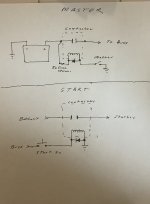FireMedic_2009
Well Known Member
I searched online to see if I can use a continuous duty relay/solenoid/contactor in place of a starter solenoid. I wasn’t able to get a clear answer so what better place to find out the answer than posting it here.
I’m currently using a White-Rogers 120-107112, which is a 14V continuous duty solenoid as my master contactor. It has 4 terminals instead of 3 terminals. https://www.copeland.com/documents/120-series-d-c-contactors-sell-sheet-en-us-1569080.pdf
Recently my starter solenoid failed and had an extra solenoid (4 terminal) I used to replace it. I want to keep an extra one in the plane especially for a cross country trip.
I ordered an extra continuous duty relay to use as a spare with the thinking I can use it to replace either the master and the starter solenoid. I know you can’t use an intermittent solenoid as a continuous duty solenoid but wasn’t absolutely sure if there was some reason why you would not want to use a continuous duty solenoid for the starter.
I do use the diodes for the solenoids. For the starter the band on the diode is connected to the S terminal and the other side is connected to ground. For the master, I have the diode connected between the two smaller terminals which are unlabeled. According to my notes a ground wire is connected to the terminal without the band of the diode. For a 3 terminal solenoid it shows the band on the diode connected to the battery terminal side and the other side of the diode to the small terminal.
In my notes there’s a document showing a blue diode used for the starter solenoid and a yellow diode for the master. Can anyone tell me what the difference is between these two diodes?
Thanks!
Daren
I’m currently using a White-Rogers 120-107112, which is a 14V continuous duty solenoid as my master contactor. It has 4 terminals instead of 3 terminals. https://www.copeland.com/documents/120-series-d-c-contactors-sell-sheet-en-us-1569080.pdf
Recently my starter solenoid failed and had an extra solenoid (4 terminal) I used to replace it. I want to keep an extra one in the plane especially for a cross country trip.
I ordered an extra continuous duty relay to use as a spare with the thinking I can use it to replace either the master and the starter solenoid. I know you can’t use an intermittent solenoid as a continuous duty solenoid but wasn’t absolutely sure if there was some reason why you would not want to use a continuous duty solenoid for the starter.
I do use the diodes for the solenoids. For the starter the band on the diode is connected to the S terminal and the other side is connected to ground. For the master, I have the diode connected between the two smaller terminals which are unlabeled. According to my notes a ground wire is connected to the terminal without the band of the diode. For a 3 terminal solenoid it shows the band on the diode connected to the battery terminal side and the other side of the diode to the small terminal.
In my notes there’s a document showing a blue diode used for the starter solenoid and a yellow diode for the master. Can anyone tell me what the difference is between these two diodes?
Thanks!
Daren





